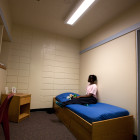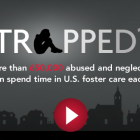

An 11-year-old denied making a threat and was allowed to return to school. Tennessee police arrested him anyway.
|
In late September, Torri was driving down the highway with her 11-year-old son Junior in the back seat when her phone started ringing.
It was the Hamilton County Sheriff’s deputy who worked at Junior’s middle school in Chattanooga, Tennessee. Deputy Arthur Richardson asked Torri where she was. She told him she was on the way to a family birthday dinner at LongHorn Steakhouse.
“He said, ‘Is Junior with you?’” Torri recalled.
Earlier that day, Junior had been accused by other students of making a threat against the school. When Torri had come to pick him up, she’d spoken with Richardson and with administrators, who’d told her he was allowed to return to class the next day. The principal had said she would carry out an investigation then. ProPublica and WPLN are using a nickname for Junior and not including Torri’s last name at the family’s request, to prevent him from being identifiable.
When Richardson called her in the car, Torri immediately felt uneasy. He didn’t say much before hanging up, and she thought about turning around to go home. But she kept driving. When they walked into the restaurant, Torri watched as Junior happily greeted his family.
Soon her phone rang again. It was the deputy. He said he was outside in the strip mall’s parking lot and needed to talk to Junior. Torri called Junior’s stepdad, Kevin Boyer, for extra support, putting him on speaker as she went outside to talk to Richardson. She left Junior with the family, wanting to protect her son for as long as she could ...

Study: Zero Tolerance Policies May Have Negative Health Implications for Students
|
A new report based on research of three California school districts suggests that school children exposed to so called, “zero tolerance” policies may be taking a toll on their mental health and wellbeing. The report, funded by the California Endowment and coordinated by Human Impact Partners (HIP), Community Asset Development Re-Defining Education (CADRE) and Restorative Justice Partners (RJP), examined three student populations in Los Angeles, Oakland and Salinas, California. It found that youth enrolled in middle and high schools that practiced zero tolerance policies were much likelier to have higher stress levels than students attending schools using alternate disciplinary models, such as positive behavioral interventions and supports (PBIS) and restorative justice (RJ) programs.
Researchers believe that stress levels are major components regarding students’ mental health and that elevated stress levels may even lead to shorter life expectancies for the populations studied. Additionally, the researchers state that students enrolled in schools using PBIS or RJ disciplinary models were, on average, more likely to have higher grades, test scores and overall attendance rates than students enrolled in schools using zero tolerance, also called exclusionary disciplinary programs. The report also says that students enrolled in schools with zero tolerance programs have higher dropout rates, participate in fewer extracurricular activities and are referred to special education programs more frequently than students attending schools with alternative disciplinary polices in place. The report states that a majority of schools in the United States use “zero tolerance” disciplinary policies, which frequently result in severe punishment - such as expulsion or arrest - for infractions involving weapons, drugs, threats and in some instances, insubordination or cursing.

Pell Grant Cuts Begin in Summer School
|
It might make for a more leisurely summer, but Kennesaw State University student Steven Welch didn’t dump college courses to have more free time. He did it because he couldn’t afford the cost. Welch, 24, had to make the move because he no longer qualified for a Pell Grant to cover the cost of summer tuition. Restrictions on the grant program, long used to help low-income and some middle-class students stem the cost of higher education, were enacted by Congress last year -- but students are feeling the impact for the first time this summer as the changes are implemented across the country. Before this summer, students could use more than the allotted $5,550 per year to help cover the cost of tuition and other school related expenses.

Trimming the Juvenile Justice Fat
|
California Gov. Jerry Brown was recently quoted telling the state Legislature to “man up” on his proposed budget cuts and yet, when it comes to juvenile justice, it seems the governor consistently bends under pressure. Unfortunately, the effects of his juvenile justice compromise will soon be felt by all California residents, according to a new CJCJ publication. With scarce and finite resources, the governor’s decision to grant a reprieve for state youth correctional facilities, in his May revised budget, creates an additional strain on already scantily-funded state services. This is the second year the governor has removed a proposal for full juvenile justice realignment from his budget. In FY 2011-12, the budget allocated counties $200,000 per state-confined youth, to increase their capacity for serving high-need juvenile offenders.

Facebook App Puts Public Inside Foster Care System
|
Each year, more than half a million children come into contact with the foster care system in the United States. Of those, 80 percent suffer from severe emotional problems, according to a report by the American Academy of Pediatrics. Less than 50 percent receive their high school diploma, and far fewer go into any type of post-secondary education. Those are some of the statistics, but what’s it’s like to walk in their shoes? What’s it like to face the tough challenges and choices these young men and women deal with on a daily basis?

Former Teen Offenders Speak Up, Make Recommendations to Improve Juvenile Justice System
|
The youth sent to the Texas Juvenile Justice System are some of the most chronic delinquent offenders in the state. Ninety-three percent are boys, 79 percent have unmarried parents, 78 percent are Hispanic or African-American, 62 percent need alcohol or drug treatment, 56 percent are from low-income families, 42 percent need mental health treatment and 36 percent have been abused or neglected. And they also have really good ideas about how to improve the juvenile justice system. In late April, a group of youth with experience in the juvenile justice system spoke at the Capitol about their recommendations to make the system more effective. The Texas Network of Youth Services (TNOYS), a nonprofit association of organizations that serve youth in at-risk situations, hired this team of young people who met at the Capitol every other Saturday throughout the school year to learn about advocacy, brainstorm ideas and practice public speaking.




